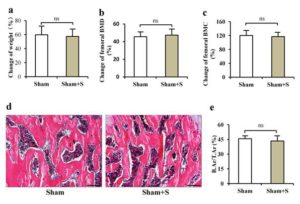eIF2alpha signaling regulates ischemic osteonecrosis through endoplasmic reticulum stress
This is the effect of salubrinal on normal animals. You can see salubrinal makes the bone more porous in the image.
14 Week old rats were used.
The dosage was 0.5mg/kg of salubrinal for 4 weeks. If salubrinal can make bone more porous than it has the potential to be used for longitudinal bone growth. Ping Zhang and Hiroki Yokota two LSJL scientists are putting a lot of effort into this so it is possible that there are effects of Salubrinal that they haven’t mentioned yet.
Here’s a hydrostatic pressure study that I found:
Microdamage assessment in equine bone resulting from high hydrostatic pressure and/or irradiation.
“HHP (~1200 MPa) was applied to non-irradiated and irradiated specimens of equine cortical bone and compared to non-pressurized controls”
“Twenty four cylindrical specimens (nominally 6.35 mm in diameter and 12.7 mm in length) were machined from the mid-diaphysis of an equine third metatarsal such that the longitudinal axis of the specimen cylinder and metatarsal were coincident. Specimens were kept hydrated throughout the machining process. Six specimens were then assigned to each of four groups: +HHP/-IR, +HHP/+IR, -HHP/-IR and -HHP/+IR (+ and – denote presence and absence, respectively). HHP was applied using a modified hydrostatic extrusion press in the manner consistent with much other work. Specimens were immersed in silicone oil at 37°C, pressurized to the desired level and immediately depressurized. In this group of specimens, 1200 MPa was the minimum pressurization value. “<1200MPa is extraordinarily high.
“microcracks were found in all fields of all specimens and ranged from 0.1 to 0.375 mm across groups. In the +HHP/+IR group, on average, 14% of the microcracks had lengths greater than 0.1 mm however in all other groups microcracks of this length comprised only 1 to 4% of the identified microcracks. The vast majority of microcracks were situated within the interstitial tissue and often in a parallel assemblage between osteons. Microcracks were found to travel along cement line interface around the osteon in just the pressurized specimens regardless of the presence or absence of irradiation. Only rarely were microcracks seen to progress across cement lines and/or lamellae ”
Figure 1 shows the microcrack images.
Here’s one with 350MPa HP.
Biomechanical investigation of the effect of high hydrostatic pressure treatment on the mechanical properties of human bone
“The bone specimens from one side were exposed to different pressure values of 300 or 600 MPa over 10 min.”
“Biomechanical properties of the cortical and trabecular bone did not decrease after exposure to 300 MPa regarding the testing parameters Young’s modulus and ultimate strength ” The study did not show any cortical bone damages so we can’t say whether there was or was not.
“Even after HHP treatment at 600 MPa the strength of bone only decreases up to 15%.”
So High Hydrostatic Pressure does damage cortical bone and cortical bone is restrictive to longitudinal bone growth but we will never be able to safely generate that much pressure in the bone.

